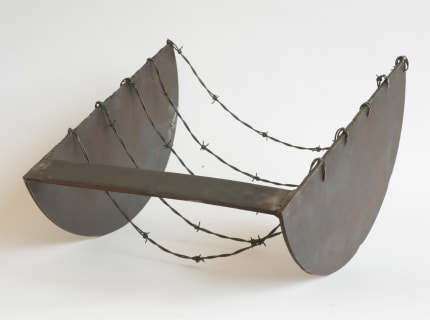The expansive survey exhibition “Graffiti,” curated by Leonie Radine and artist Ned Vena, begins in 1951—the year spray paint was patented in the United States. This seemingly banal technical footnote functions as a clear material marker: the pressurized paint can prefigured a wider transformation in postwar conceptual art practices and beyond. Central to this curatorial narrative is the short period when spray paint was embraced by studio-based artists in the 1950s and ’60s, seemingly drawn to its vaporous, cool finish. This was upended when spray paint started to appear on streets, subways, and bus shelters across New York City, Los Angeles, and Philadelphia through the 1960s: a period that continues to shape conceptions of “graffiti,” largely imagined by marginalized African American and Latinx youth—the exhibition overall tilts towards this US perspective.
If the modern city provides scant refuge for the politically conscious, immigrants, and the socially precarious (including communities engaged in sex work, cruising, or drug taking), then graffiti here retains its image as its persistent mise-en-scène. The poet Anne Carson described graffiti as “often ugly and usually, on some level, activist,” yet this exhibition largely eschews any overt political messaging, instead repositioning graffiti as an unconscious manifestation of a lifeworld largely held by force under the surface of a city by force, painted emanations momentarily registered upon its surfaces only to be latterly scrubbed off by sunrise.1 Such associations of graffiti as a temporary mark of countercultural resistance shift weight throughout the exhibition, yet the context of Bolzano (a laidback, affluent mountain town in northern Italy) undercut any sentimental attachments, bringing to mind neoconservative, “broken window theory” policies, consequent surveillances, and strangleholds of private space.
Such divisive tensions are found in the exhibition’s opening work: Ben Solomon’s short video Dirty Laundry (False & Blake) (2023), in which a graffiti writer tags buildings around Times Square at night. Coupled with the looping synthpop of Don Henley’s 1982 track “Dirty Laundry,” it reads as an ironic riposte to the area’s well-documented history of gentrification. This glimpse of unauthorized lexical attributions to the cityscape is briefly brought to institutional heel with a selection of works from the 1950s and ’60s that also offer some respite from the otherwise male-dominated arena of street graffiti artists. These works include dense overlays of rivetted steel girders by Hedda Sterne; a toxic haze of reds and high-altitude blues in a work by Charlotte Posenenske and Carol Rama’s Forgive my Conjunctions (1968), a seeming silhouette of a body flung into space. Nearby, Martin Barré’s serial strikes of black spray paint evoke the slashes of Lucio Fontana’s monochromes.
The exhibition also obliquely draws parallels to the 1959 development of the telephoto lens for the 35mm camera. The capacity of this lens to zoom, distort, and destabilize spatial orientation mirrors the layered, often vertiginous composition of the city itself. The works of Sterne, but also David Smith and Melvin Edwards’s sprayed and splattered negative of chains from 1974, all latently use the mechanical propulsion of paint to produce a clear photographic indexicality of an object but to also apply a deep focus-like range through superimpositions.
Edwards’s work connects to his “Lynch Fragments” series; sculptures using link chain and barbed wire made in response to the racial violence in America and to the Vietnam War. Such political temperatures are potently kept in the air, much like the fine spray of the paint. But the outside world does condense with the inclusion of works by graffiti writers made during its highwater period of 1981 to 1984, including Blade, Seen, Dondi White and Rammellzee (who currently has a show at Palais de Tokyo in Paris). Executed on canvas, these pieces now serve as some of the only extant records of their original innovations—works that take on further talismanic presence when learning that certain colors are discontinued; the aptly named Red Devil paint is no longer on sale. Here, the unwaged labor of tagging the street is transposed into the gallery space, not only as a matter of safety and legality, but as a calculated navigation of cultural capital.
The influence of such artists living and working on the Lower East Side upon the art market in the 1980s is perhaps most clearly encapsulated in the collaborations between Jenny Holzer and Lady Pink, and Martin Wong and LA2. Further questions of authorship—a recurrent theme in graffiti culture, where pseudonyms and collective tags operate as signals of allegiance—put the post-conceptual practices of Michael Krebber, Heike-Karin Föll, and Karin Sander under subtle pressure. Shown together along a corridor, their minimal use of spray paint, an often-breathless amount of black paint onto white canvas, breezily collapse the axis between authorial identity and currencies of artistic expression. The works also hold a surprising curatorial spur, staging the financialized and conceptual distance between the street and the gallery, where margin and center appear as alien life forms to one another.
...
Read full review at e-flux.com.

